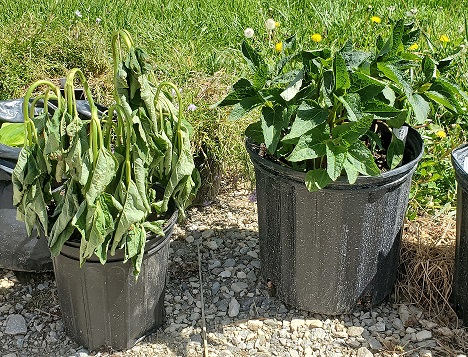By Caitlin Wilson 6 May 2023
Have you ever lost a vegetable seedling after you transplanted it? Have you ever wondered why your transplanted seedlings look so droopy after transplanting? Have you experienced incredibly slow growth after transplanting your seedlings? Read on to learn how to avoid or minimize these transplanting issues!
What is transplant shock?
Plants are meant to be grown in the same place over their entire lifespan. When plants are moved, their roots often suffer some damage from either being dug up or from handling during transplantation. Transplant shock occurs as a reaction to your plants being moved into the ground. Some plants are more susceptible to transplant shock than others.
During transplantation, the roots of the plant get disturbed and this keeps the plant from being able to absorb water. You may have experienced wilting after transplanting even though you have thoroughly watered the plant. If you see this, DO NOT water the plant more. The transplanting process has damaged the very small baby roots that are responsible for absorbing water. The plant will not be able to absorb more water until they repair these roots. This process usually takes about a week or so. So only water the soil if it becomes dried out.

How Can I Avoid Transplant Shock?
Transplanting a plant is an inherently traumatic event, but there are a few things you can do to minimize the damage.
- Transplant your plants in the evening after the harshest sun is gone. Giving your plants time overnight to adjust to the new conditions can help them recover from the shock of being moved.
- Transplant on a day when the wind will be calm. Indoor kept plants do not experience wind and will have weaker stems since wind stimulates plants to grow thicker stems.
- Transplant at the right time (for certain plants). Some plants such as okra, peppers, basil, tomatoes, and squash plants are frost sensitive. This means they will die when exposed to temperatures below 34-38F. Transplant after all threat of this weather has gone (this is typically after Mother’s day in Ohio). Plants like salad, brassicas, and some herbs like oregano, mint, and sage are frost hardy and can be transplanted earlier if healthy and large enough.
- Remove any dead parts before transplanting. You don’t want your plants to spend energy trying to repair or maintain dead or dying plant parts. If you remove these dead or dying parts, the plant will be able to devote all of its energy to growing new parts and repairing anything damaged during the transplantation.
- Try not to disturb the roots during transplantation! The baby roots that are responsible for water absorption can be damaged during transplantation. Take care to not disturb the root ball in the plants. Plant the entire soil block without breaking up the roots because breaking up the roots can damage them. If you don’t break these roots, you are less likely to see wilting in a transplanted plant.
- Water the plant well. Consider watering the plant in it’s pot BEFORE you transplant it. Then after digging your hole, water the bottom of the hole well. Fill the hole in with dirt after planting, and make a small moat around the the base of the plant. Fill the moat and allow the water to soak into the dirt completely. Water the next day or as needed from here forward.
- Consider using Epsom salt to help your roots recover. Gardening Calendar suggests using Epsom salts as support to help your plant regrow roots faster. They suggest using 1 tablespoon of Epsom salt per 1 gallon of water to water your plants after transplanting.
- Choose healthy plants to transplant Healthy plants will transplant more easily than struggling plants. A stressed plant will be less likely to survive the transplantation because the event adds more stress. Plants that have become root bound will also be more likely to shock when you transplant them.
Keep in mind that plants have been kept indoors or in greenhouses can sunburn. Typically this can make your plants’ leaves appear brown or white and possibly crunchy. You can minimize this by hardening off your plants. In our experience, sunburn rarely kills plants, it just makes them appear ugly for a week or two. If you see new growth on the plant, it will most likely survive and you just have to wait for the plant to heal. Wait until the new leaves are established to remove the old, sun damaged leaves!


